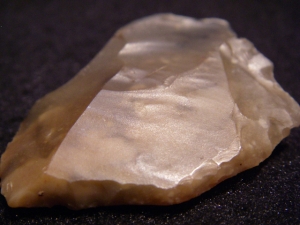Chesterfield Farm Lithic Material: An Update
Some more photographs of the artefacts recovered at Chesterfield Farm have been taken by Gerry. The most significant find is that of the projectile point. This is produced on a flint of good quality and therefore the raw material is unlikely to have derived from this region. Instead, it is likely to have been transported here through exchange mechanisms that were established in the Neolithic and Bronze Age. The find is hitherto the only specimen that permits a reasonably good typo-chronological dating of the site.
Near Chesterfield Farm, Julia Graham of Paxton found a splendid scraper whilst walking her dog ! This is probably coeval with the aforementioned projectile point:
Notice the regular and rather steep retouch that can be seen on the margins of this specimen. An implement such as this was used to scrape animal hides; this might have been used to process skins from wild animals such as deer and aurochs, or domestic animals such as cattle and sheep. Although agriculture was widespread in the Neolithic and the Bronze Age, providing the economic foundation of settlement, there was still a considerable amount of hunting. Moreover, we must not forget the possibility that these implements might have been used to process fish and scrape the scales from salmon and trout in the River Whiteadder.
Some unusual raw material has also been recovered. A blade produced in what is most likely chalcedony was found by John in the vicinity of the main features occurring at Chesterfield Farm. This material is usually poorly represented in collections from the region and we are keen to find more specimens, even if this consists only of waste fragments.
Finally, it is important to underscore that we have raw material of different types occurring on the site. This may represent different procurement strategies, but my also signal that the site was used over a much longer period than we currently suspect. We obviously must consider this possibility and recognise that a good location for settlement, agriculture or hunting in one period is likely to remain attractive unless there is a fundamental change in economic structure or the landscape undergoes profound transformations. To borrow a term from the palaeographers, these sites would represent a palimpsest of occupation. We will have to await further evidence from the features or radiocarbon dates to be certain about this.
Below is an image of a selection of finds from Chesterfield Farm :



